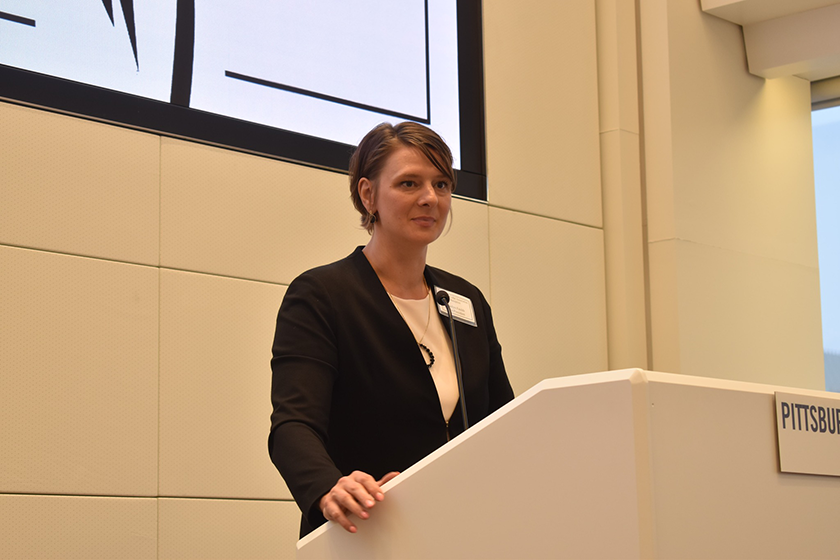PA Federal Business Decisions Volume 18A, No. 1
Kelly A. Williams and Henry M. Sneath, Business Decisions Editors (Originally published in the Spring 2014 edition of the Pennsylvania Bar Association’s Civil Litigation Update)
Third Circuit Finds Falsity of Defendant’s Statement Carries Same Meaning for Defamation and False Light Invasion of Privacy
In Graboff v. The Colleran Firm, 744 F.3d 128 (3d Cir. 2014), the Third Circuit upheld a jury’s verdict awarding damages to the plaintiff, Steven R. Graboff (“Graboff”). Graboff had sued the American Academy of Orthopaedic Surgeons and the American Association of Orthopaedic Surgeons (“AAOS”) after the AAOS published an article relating to a grievance proceeding against Graboff. Graboff alleged that the article was defamatory and constituted a false light invasion of privacy as the article only addressed selective facts that implied he had testified falsely as an expert witness in a malpractice case. At trial, the jury answered interrogatories that the article did not contain false statements but did contain statements that portrayed Graboff in a false light. As a result, the jury awarded damages. The district court ruled the jury found in favor of Graboff on the false light count but in favor of the AAOS on the defamation count. The AAOS appealed on the basis that the jury answers were inconsistent. The Third Circuit held that the answers could be reconciled and that the district court erred in failing to rule in Graboff’s favor on both counts.
The case arose out of a malpractice case in which Graboff had prepared a preliminary expert report. The law firm representing the plaintiff used the report without Graboff’s consent or knowledge and had whited out Graboff’s “Draft Report” designation. The doctor named as the defendant in the malpractice case filed a grievance against Graboff with the AAOS, alleging that Graboff violated the AAOS’s Standards of Professionalism by failing to provide honest and accurate testimony. At the grievance hearing, Graboff testified that he believed his report was a preliminary report only and admitted that his report was flawed because he had not seen relevant x-rays at the time he prepared his draft. The AAOS found that Graboff violated the Standards of Professionalism and published a summary of the grievance proceeding, which omitted Graboff’s exculpatory testimony.
Applying Pennsylvania law, the Third Circuit examined the elements of defamation and false light invasion of privacy, including the defenses for these claims. A defendant can defend a defamation claim on the grounds that its statements were “substantially true.” However, “a defamatory statement must be viewed in context, and a defendant cannot use truth as a defense where ‘the implication of the communication as a whole was false,’ even if the statement is ‘literally accurate.’” While there is no Pennsylvania Supreme Court case on point, the lower Pennsylvania courts have held that defamation may be established where a statement viewed in context creates a false implication.
Following the Restatement (Second) of Torts’ definition of “false light invasion of privacy,” Pennsylvania imposes liability on a person “who publishes material that ‘is not true, is highly offensive to a reasonable person and is publicized with knowledge or in reckless disregard of its falsity.’” The Pennsylvania Superior Court has held that a plaintiff can establish falsity “by showing that a defendant ‘selectively printed or broadcasted true statements or pictures in a manner which created a false impression.’” As a result, like defamation, even if literally true, the “discrete presentation of information in a fashion which renders the publication susceptible to inferences casting one in a false light entitles the grievant to recompense for the wrong committed.”
In the present case, the Third Circuit held that falsity with respect to a defendant’s statement carries the same meaning in the defamation and false light invasion of privacy contexts. As a result, “publication of factually correct statements that convey a false impression can be actionable as defamation (if the statements had a grievous effect on one’s reputation), or actionable as a false light invasion of privacy (if the statements would be highly offensive to a reasonable person).”
As a result, the court was able to reconcile the jury’s responses to interrogatories in which the jury found that the article did not contain false statements but did contain statements that portrayed Graboff in a false light and that the AAOS acted knowingly or with reckless disregard for the truth. The responses supported a finding of liability in favor of Graboff not just on the false light invasion of privacy count but also the defamation count. In fact, the Third Circuit found that the district court had erred in finding in favor of the AAOS on the defamation count. However, the error was harmless because the jury calculated damages for defamation and false light invasion of privacy together as a single unit. Consequently, the Third Circuit affirmed the order denying the AAOS’s motion for judgment as a matter of law and for judgment notwithstanding the verdict.
Stock Photographer Overcomes Textbook Publisher’s Motion to Dismiss in Copyright Infringement Action
The decision in Visuals Unlimited, Inc. v. Pearson Education, Inc., Civ. Action No. 13-5681, 2014 U.S. Dist. LEXIS 49590 (E.D. Pa. Apr. 10, 2014) (opinion by J. Slomsky) involved Visuals Unlimited’s licensing of various stock photos to Pearson Education, a textbook publisher. Plaintiff alleged that Pearson printed more photos than the licenses permitted, printed some photos without any approval and distributed photos to third parties without Plaintiff’s permission.
After dropping its breach of contract and breach of covenant of good faith claims, Plaintiffs alleged copyright infringement, contributory copyright infringement and fraud in its Amended Complaint. Pearson filed a motion to dismiss the latter two claims and the court denied the motion on both counts.
With respect to the contributory copyright infringement claim, the court began by outlining the elements of pleading this claim:
(1) the direct copyright infringement by a third party; (2) knowledge of the defendant that the third party was directly infringing; and (3) defendant induced, caused, encouraged or materially contributed to the infringement.
Rejecting Pearson’s argument that Plaintiff did not plead sufficient facts to show that Pearson knew that third parties were reproducing photos without permission and that it materially contributed to the infringement, the court noted that the issue of whether a claim is sufficiently pleaded is a close question. Citing other district courts, and accepting Plaintiff’s factual allegations as true, the court declined to place a heavier burden on Plaintiff and held that it sufficiently alleged Pearson’s knowledge of third party infringement and material contribution to the infringement.
With respect to the fraud claim, the court similarly held that Plaintiff sufficiently pled its claim. Pearson asserted four arguments in support of its motion to dismiss the fraud claim including the gist of the action doctrine, the economic loss doctrine, failure to allege fraud damages and failure to plead fraud with particularity. The court rejected each argument in turn. As to the gist of the action doctrine, the court noted that Plaintiff did not allege a breach of contract action nor did they allege that Pearson failed to pay for licenses which it sought and obtained from Plaintiff. Instead, Plaintiff asserted that a fraud was committed by Pearson during the negotiations, prior to formation of the contract. The gist of the action doctrine was therefore, inapplicable.
Turning to the economic loss doctrine, the court similarly rejected Pearson’s argument that no harm was alleged independent of the harm flowing from the breach of the licenses. Noting again that Plaintiff did not seek to recover damages flowing from a contract, the court cited Wood v. Houghton Mifflin Harcourt Publ’g Co., 589 F. Supp. 2d 1230 (D. Colo. 2008) that explained that harm from fraud was the lost opportunity of the copyright holder to have its rightful licensing fee up front, as well as the risk that the infringement may not have been discovered in the absence of litigation. As Plaintiff alleged similar harm in its Amended Complaint, the court rejected the application of the economic loss doctrine. Applying the above reasoning, the court also declined to accept Pearson’s damages argument. The court found that Plaintiff sufficiently alleged fraud damages because Plaintiff alleged that it billed at a lower rate than it would have if Pearson had disclosed the actual number of textbooks it intended to print.
The court finally turned to Pearson’s assertion that Plaintiff failed to plead fraud with particularity pursuant to Federal Rule of Civil Procedure 9(b) which requires a heightened pleading standard for fraud claims. The court began by stating the six elements required under Pennsylvania law to allege fraud:
(1) a representation; (2) which is material to the transaction at hand; (3) made falsely, with knowledge of its falsity or recklessness as to whether it is true or false; (4) with the intent of misleading another into relying on it; (5) justifiable reliance on the misrepresentation; and (6) the resulting injury was proximately caused by the reliance.
Applying these requirements to the case at bar, the court found that specific factual allegations, including the actual numbers of textbooks printed in relation to the number of licenses held as well as allegations that Plaintiff relied on Pearson’s representations regarding the number of textbooks it intended to produce, was sufficient to adequately allege fraud. Pearson’s motion to dismiss was therefore denied as to both the contributory copyright infringement and fraud claims.
–Contributed by Cara Disheroon, Esq., Houston Harbaugh, Pittsburgh, Pennsylvania; cdisheroon@psmn.com
“Who Wants to Be a Lead Plaintiff in a Securities Fraud Class Action Litigation?”-Court Allows Aggregation of Losses to Satisfy Lead Plaintiff Criteria Under the PSLRA
In West Palm Beach Police Pension Fund v. DFC Global Corp., Civ. Action No. 13-6731, 2014 U.S. Dist. LEXIS 49595 (E.D. Pa. Apr. 9, 2014), the court tackled the appointment of a lead plaintiff in a securities class action case when three parties sought lead plaintiff designation. The court began its review of the matter by referencing the famous tv-game show, “Who Wants To Be A Millionaire?” The underlying case was controlled by the Private Securities Litigation Reform Act (“PSLRA”). The Complaint contained allegations, inter alia, that DFC Global concealed from investors that it systematically issued high-fee, predatory loans to consumers unable to repay them. The plaintiffs were all shareholders of DFC’s stock and sought designation as the lead plaintiff. Pursuant to the PSLRA, when multiple parties seek lead plaintiff designation, the court must appoint as lead the “most adequate plaintiff,” defined as the member or members of the purported class that the court determines to be most capable of adequately representing the interests of the class members. Id. Determining the adequacy of a particular plaintiff involves determining plaintiff with “the largest financial interest in the relief sought by the class.” Id. citing 15 U.S.C. § 78u-4(a)(3)(B)(iii)(I)(bb) . Once that element is determined, the court must decide whether the entity satisfies the requirements of Rule 23 of the Federal Rules of Civil Procedure, which requires a prima facie showing of typicality and adequacy.
One of the entities seeking lead plaintiff status, the “Institutional Investor Group,” included four separate investor groups: the West Palm Beach Police Pension Fund, the Arkansas Teachers Retirement System, the Macomb County Employees Retirement System and the Laborers’ District Council and Contractors’ Pension Fund of Ohio. The Institutional Investor Group claimed that its financial interest in this litigation was a loss of $923,872 using either the first-in-first-out (“FIFO”) or last-in-first-out (“LIFO”) methods of loss calculation. Another entity seeking lead plaintiff status, the Plumbers and Pipefitters, argued that it had a greater financial stake in the outcome using the FIFO method of calculation with a loss of $937,492. However, the loss suffered by that same group using the LIFO method resulted in a loss calculated at $547,725. Under the FIFO method, a court matches the sale of a share of stock to the price paid for the oldest share remaining in inventory. Using the LIFO method, the court matches the sale of a share of stock to the price paid for the newest share in inventory.
The court ultimately employed the LIFO method of calculating financial impact, based upon other courts recent reliance upon that method. However, the Plumbers and Pipefitters took its argument further and argued that the Institutional Investor Group consisted of unrelated investors, and therefore, the court should not allow the four entities comprising the group to aggregate their losses. Moreover, the Plumbers and Pipefitters argued that the Institutional Investor Group was “pieced together by counsel for the sole purpose of being appointed lead plaintiff and gaining control of the litigation, a result that the PSLRA seeks to avoid.” Id. at *13.
Ultimately, the court in this case concluded that the law in the Third Circuit is clear that a group of investors can serve as lead plaintiff and need not be related to be appointed lead plaintiff. Further, the court stated that the lack of precedent or guidance on this matter warranted a conclusion that aggregation of loss should be decided on a case-by-case basis. The court specifically noted the concerns of the other plaintiff that, “the opportunity to direct this litigation offers an incentive for creative lawyering and perhaps some gamesmanship. However, the individual members of the Institutional Investor Group submitted a joint declaration made under penalty of perjury that stated they asked their lawyers to ‘seek our like-minded investors and determined, after conferring with each other, to seek joint appointment as Lead Plaintiff.’” Id. at *21. The court reasoned that it had no basis to doubt the veracity of the statement made by the four members of the group, despite the fact that they were unrelated entities. The court also held that the Institutional Investor Group met the requirements of typicality and adequacy as its claims were representative of the claims of the class, and it apparently could fairly and adequately protect the interests of the class during the litigation.
Judge Quashes Federal Question in Close Corporation Quarrel
Judge Gardner of the Eastern District of Pennsylvania recently rejected a plaintiff’s claim that a dispute among three joint owners of a close corporation gave rise to a violation of the Securities Exchange Act of 1934. In Rossi v. Quarmley et al., No. 12-cv-7270, 2014 U.S. Dist. LEXIS 39705 (E.D. Pa. Mar. 25, 2014) (opinion by J. Knoll Gardner), Plaintiff and two Defendants each owned 1/3 of Defendant Principia Partners, LLC, and Plaintiff alleged that the two Defendants violated statutory and common law in the course of forcing him to sell his interests in Principia to them.
Defendants moved to dismiss Plaintiff’s lone federal claim – for a violation of the Securities Exchange Act – on the grounds that: 1) the three Principia principals were active investors; and 2) the Securities Exchange Act only affords relief to passive parties who reap rewards “solely from the efforts of others.” Id. at *13 (following Securities and Exch. Comm’n v. Howley, 328 U.S. 293, 301 (1946)). Judge Gardner, who noticed that Principia’s operating agreement enabled Plaintiff to be an active investor, and that Plaintiff’s Complaint alleged that he had engaged in “hard work” on Principia’s behalf, agreed. Id. at *15. He dismissed Plaintiff’s federal securities claim and remanded the case to state court for disposition of pending state law claims. Id. at *17.
–Contributed by Jason Spak, Houston Harbaugh, Pittsburgh, Pennsylvania; jspak@psmn.com
Sour Grapes: Produce Broker’s “Compiled” Customer List not Protectable as a Trade Secret
In Ozburn-Hessey Logistics, LLC v. 731 Logistics, LLC, No. 12-0864, 2014 U.S. Dist. LEXIS 48421 (E.D. Pa. April 7, 2014), Judge Restrepo of the U.S. District Court for the Eastern District of Pennsylvania was called upon to decide whether a competing produce broker, Defendant 731 Logistics, LLC (“Competitor”), had violated the Pennsylvania Uniform Trade Secret Act when it hired the employees of another produce broker, Plaintiff Ozburn-Hessey Logistics, LLC (“Broker”), and solicited the Broker’s customers. Id. at *17-19. It was the Broker’s position that the list of its customer contacts “compiled” by the Competitor was a protected trade secret. Id. at *17. The court disagreed with the Broker’s theory, but nonetheless permitted the claim to go forward against the Competitor and certain principals of the Competitor on other grounds.
According to the court, the Competitor’s list of customer contacts did not qualify for trade secret protection because the list was the product of the sole efforts of the Competitor, not the Broker. Id. at *17-19. Because a fact issue existed as to whether the identities of the customers (either individually or in combination) on the “compiled” list were subject to trade secret protection, however, the court declined to dispose of the claim entirely. Id. at *19-22. In addition, the court also permitted causes of action for unfair competition, breach of contract, and civil conspiracy to proceed against the Competitor and certain principals, but not the employees who had left the Broker to join the Competitor. Id. at *22-33. With respect to the employees, the court found that there was insufficient evidence of wrongdoing on their part to permit the causes of action that had been asserted against them to go forward. Id. Moreover, for this same reason, the court declined to find that the employees had breached their duty of loyalty to the Broker. Id. at *33-37. Finally, the court granted summary judgment in favor of the Competitor and certain principals on the Broker’s tortious interference claim because evidence that the Defendants specifically intended one of the principals to breach his contact with the Broker was lacking. Id. at *29-32.
Court Grants Summary Judgment in Favor of Patentee Based on Collateral Estoppel in Unusual Dual Litigation Situation
In a rather contorted procedural history, the court in Arlington Industries, Inc. v. Bridgeport Fittings, Inc., No. 3:06-CV-1105, 2014 U.S. Dist. LEXIS 56869 (M.D. Pa. Apr. 24, 2014) (opinion by J. Connor), granted summary judgment of infringement in favor of the patentee based on collateral estoppel from a prior jury’s decision in a related case.
Arlington and Bridgeport were “fierce” competitors in the electrical conduit fitting industry. Arlington brought suit against Bridgeport in a different action before a different judge in the Middle District of Pennsylvania (“Arlington I”), alleging that Bridgeport infringed Arlington’s 5,266,050 patent (“the ‘050 patent”) by selling a Single Connector snap-in product. During the discovery phase of Arlington I, Arlington amended its complaint and asserted that Bridgeport also infringed the ‘050 patent through its sale of its Duplex Connectors.
While Arlington I was proceeding, but before asserting infringement of the Duplex Connectors, Arlington brought suit against Bridgeport in the instant action (“Arlington II”) asserting that Arlington infringed the ‘050 patent and another patent by selling its Duplex Connectors. Thus, after Arlington’s Amended Complaint in Arlington I, Arlington and Bridgeport were simultaneously litigating whether the Duplex Connectors infringed the ‘050 patent before two different judges in the same court. The parties never bothered to inform either judge until much later in the proceedings.
Both judges issued claim constructions of the ‘050 patent, which turned out to be materially different. The two courts also reached different results at the summary judgment stage. The Arlington II court granted summary judgment of non-infringement for the Duplex Connectors, while the Arlington I court denied the parties’ cross-motions for summary judgment and set a trial date.
Bridgeport filed a motion to stay the Arlington I trial mere days before it was set to begin based on claim and issue preclusion from the summary judgment ruling in the Arlington II case. The Arlington I court denied the motion, but severed the claims relating to the Duplex Connectors. A jury found that Bridgeport infringed the ‘050 patent through its sale of the Single Connectors.
After trial, Bridgeport renewed its motion for judgment as a matter of law regarding the Duplex Connectors based on the Arlington II judge’s grant of summary judgment. The Arlington I judge granted the motion and entered judgment in Bridgeport’s favor. The parties appealed these decisions to the Federal Circuit, which vacated the grant of summary judgment of non-infringement of the Duplex Connectors in the Arlington II case based on an erroneous claim construction and affirmed the jury’s finding of infringement of the Single Connectors in the Arlington I case. On remand, the cases were consolidated before the Arlington I judge.
Based on all of the rulings, Arlington moved for summary judgment of infringement of the ‘050 patent by Duplex Connectors. Burlington conceded that all of the elements of the claim of the ‘050 patent were present in the Duplex Connector except for one-the “outwardly sprung members.” Arlington argued that Burlington was estopped from arguing that this element was not present because the Burlington had lost on the same issue with respect to the Single Connector in the jury trial in Arlington I.
Under principles of issue preclusion or collateral estoppel, a party cannot re-litigate an issue that was conclusively determined in a prior lawsuit and that was essential for the judgment. The court found that both the Single Connector and the Duplex Connector had the identical elements-a tensioning tang-that the jury had already found satisfied the “outwardly sprung members” element in the ‘050 patent. The court further found that there was no other way that the jury could have rationally found infringement, and therefore, the determination was essential to its judgment. Thus, the court entered summary judgment in favor of Arlington based on collateral estoppel, finding that there were no material issues of fact and that the Duplex Connector infringed the ‘050 patent.







